1/11
@_philschmid
This is not a joke! Excited to share DolphinGemma the first audio-to-audio for dolphin communication! Yes, a model that predicts tokens on how dolphin speech!
Excited to share DolphinGemma the first audio-to-audio for dolphin communication! Yes, a model that predicts tokens on how dolphin speech!
> DolphinGemma is the first LLM trained specifically to understand dolphin language patterns.
> Leverages 40 years of data from Dr. Denise Herzing's unique collection
> Works like text prediction, trying to "complete" dolphin whistles and sounds
> Use wearable hardware (Google Pixel 9) to capture and analyze sounds in the field.
> Dolphin Gemma is designed to be fine-tuned with new data
> Weights coming soon!
Research like this is why I love AI even more!
https://video.twimg.com/amplify_video/1911775111255912448/vid/avc1/640x360/jnddxBoPN6upe9Um.mp4
2/11
@_philschmid
DolphinGemma: How Google AI is helping decode dolphin communication
3/11
@IAliAsgharKhan
Can we decode their language?
4/11
@_philschmid
This is the goal.
5/11
@_CorvenDallas_
@cognitivecompai what do you think?
6/11
@xlab_gg
Well this is some deep learning
7/11
@coreygallon
So long, and thanks for all the fish!
8/11
@Rossimiano
So cool!
9/11
@davecraige
fascinating
10/11
@cognitivecompai
Not to be confused with Cognitive Computations Dolphin Gemma!
https://huggingface.co/cognitivecomputations/dolphin-2.9.4-gemma2-2b
11/11
@JordKaul
if only john c lily were still alive.
@_philschmid
This is not a joke!
> DolphinGemma is the first LLM trained specifically to understand dolphin language patterns.
> Leverages 40 years of data from Dr. Denise Herzing's unique collection
> Works like text prediction, trying to "complete" dolphin whistles and sounds
> Use wearable hardware (Google Pixel 9) to capture and analyze sounds in the field.
> Dolphin Gemma is designed to be fine-tuned with new data
> Weights coming soon!
Research like this is why I love AI even more!
https://video.twimg.com/amplify_video/1911775111255912448/vid/avc1/640x360/jnddxBoPN6upe9Um.mp4
2/11
@_philschmid
DolphinGemma: How Google AI is helping decode dolphin communication
3/11
@IAliAsgharKhan
Can we decode their language?
4/11
@_philschmid
This is the goal.
5/11
@_CorvenDallas_
@cognitivecompai what do you think?
6/11
@xlab_gg
Well this is some deep learning
7/11
@coreygallon
So long, and thanks for all the fish!
8/11
@Rossimiano
So cool!
9/11
@davecraige
fascinating
10/11
@cognitivecompai
Not to be confused with Cognitive Computations Dolphin Gemma!
https://huggingface.co/cognitivecomputations/dolphin-2.9.4-gemma2-2b
11/11
@JordKaul
if only john c lily were still alive.
1/37
@GoogleDeepMind
Meet DolphinGemma, an AI helping us dive deeper into the world of dolphin communication.
https://video.twimg.com/amplify_video/1911767019344531456/vid/avc1/1080x1920/XMoZ_rgM3cVPK2Kz.mp4
2/37
@GoogleDeepMind
Built using insights from Gemma, our state-of-the-art open models, DolphinGemma has been trained using @DolphinProject’s acoustic database of wild Atlantic spotted dolphins.
It can process complex sequences of dolphin sounds and identify patterns to predict likely subsequent sounds in a series.
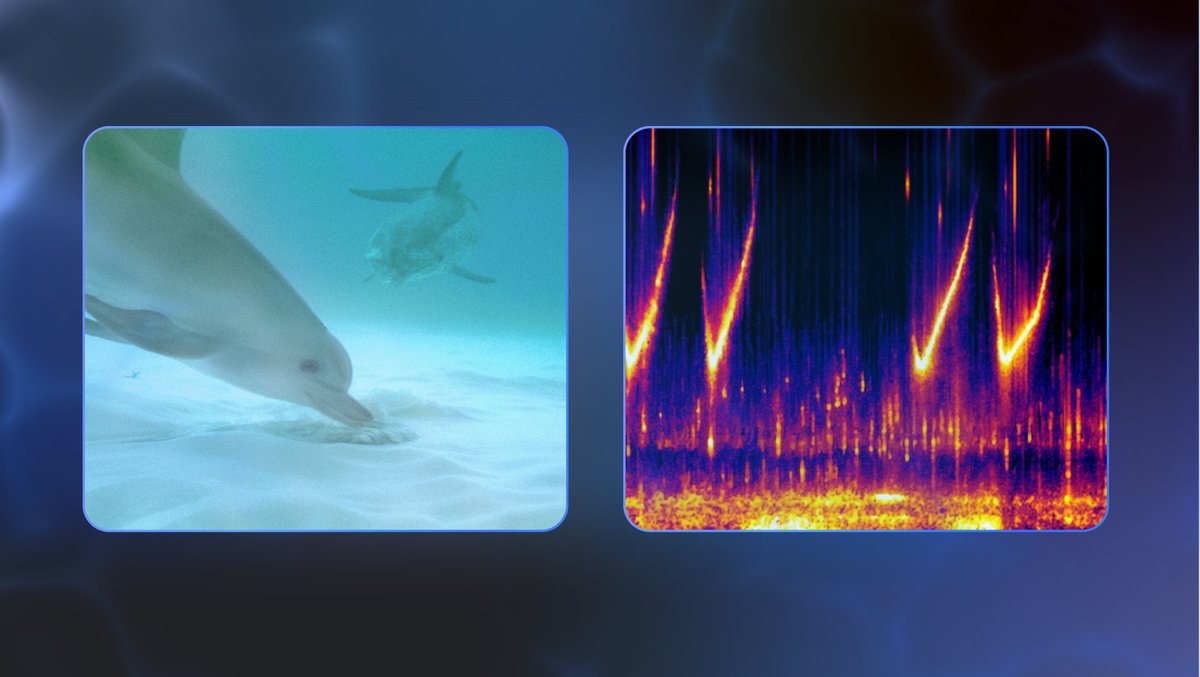
3/37
@GoogleDeepMind
Understanding dolphin communication is a long process, but with @dolphinproject’s field research, @GeorgiaTech’s engineering expertise, and the power of our AI models like DolphinGemma, we’re unlocking new possibilities for dolphin-human conversation. ↓ DolphinGemma: How Google AI is helping decode dolphin communication
4/37
@elder_plinius
LFG!!!
[Quoted tweet]
this just reminded me that we have AGI and still haven't solved cetacean communication––what gives?!
I'd REALLY love to hear what they have to say...what with that superior glial density and all
[media=twitter]1884000635181564276[/media]
5/37
@_rchaves_
how do you evaluate that?
6/37
@agixbt
who knew AI would be the ultimate translator
7/37
@boneGPT
you don't wanna know what they are saying

8/37
@nft_parkk
@ClaireSilver12
9/37
@daniel_mac8
Dr. John C. Lilly would be proud
10/37
@cognitivecompai
Not to be confused with Cognitive Computations' DolphinGemma! But I'd love to collab with you guys!
cognitivecomputations/dolphin-2.9.4-gemma2-2b · Hugging Face
11/37
@koltregaskes
Can we have DogGemma next please?
12/37
@Hyperstackcloud
So fascinating! We can't wait to see what insights DolphinGemma uncovers

13/37
@artignatyev
dolphin dolphin dolphin
14/37
@AskCatGPT
finally, an ai to accurately interpret dolphin chatter—it'll be enlightening to know they've probably been roasting us this whole time
15/37
@Sameer9398
I’m hoping for this to work out, So we can finally talk to Dolphins and carry it forward to different Animals
16/37
@Samantha1989TV
you're FINISHED @lovenpeaxce
17/37
@GaryIngle77
Well done you beat the other guys to it
[Quoted tweet]
Ok @OpenAI it’s time - please release the model that allows us to speak to dolphins and whales now!
[media=twitter]1836818935150411835[/media]
18/37
@Unknown_Keys
DPO -> Dolphin Preference Optimization
19/37
@SolworksEnergy
"If dolphins have language, they also have culture," LFG
20/37
@matmoura19
getting there eventually
[Quoted tweet]
"dolphins have decided to evolve without wars"
"delphinoids came to help the planet evolve"
[media=twitter]1899547976306942122[/media]
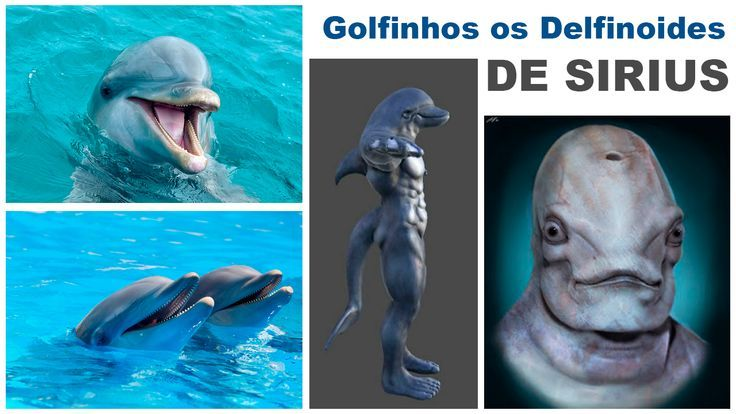
21/37
@dolphinnnow
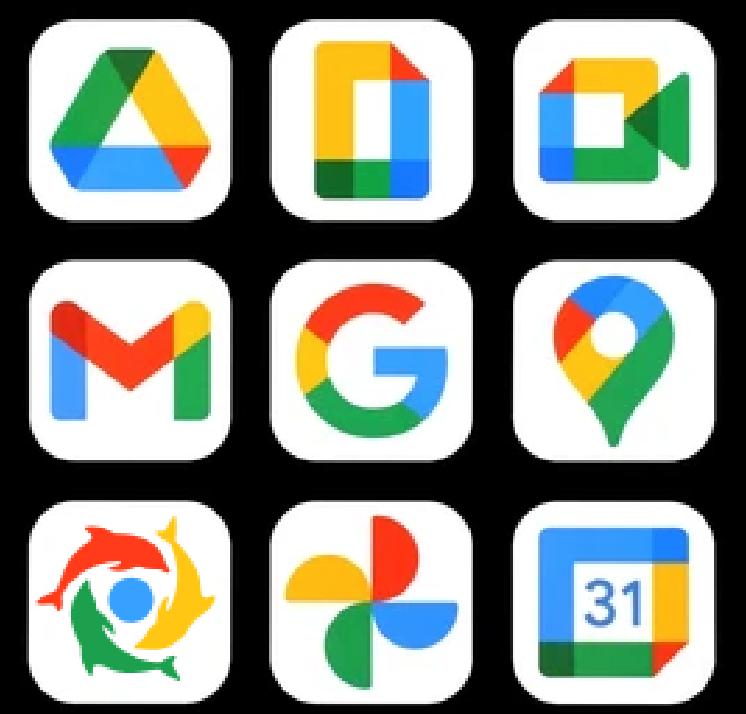
22/37
@SmokezXBT
Dolphin Language Model?
23/37
@vagasframe
🫨
24/37
@CKPillai_AI_Pro
DolphinGemma is a perfect example of how AI is unlocking the mysteries of the natural world.
25/37
@NC372837
@elonmusk Soon, AI will far exceed the best humans in reasoning
26/37
@Project_Caesium
now we can translate what dolphines are warning us before the earth is destroyed lol
amazing achievement!

27/37
@sticksnstonez2
Very cool!
28/37
@EvanGrenda
This is massive @discolines
29/37
@fanofaliens
I would love to hear them speak and understand
30/37
@megebabaoglu
@alexisohanian next up whales!
31/37
@karmicoder

 I always wanted to know what they think.
I always wanted to know what they think.
32/37
@NewWorldMan42
cool
33/37
@LECCAintern
Dolphin translation is real now?! This is absolutely incredible, @GoogleDeepMind
34/37
@byinquiry
@AskPerplexity, DolphinGemma’s ability to predict dolphin sound sequences on a Pixel 9 in real-time is a game-changer for marine research! How do you see this tech evolving to potentially decode the meaning behind dolphin vocalizations, and what challenges might arise in establishing a shared vocabulary for two-way communication?
How do you see this tech evolving to potentially decode the meaning behind dolphin vocalizations, and what challenges might arise in establishing a shared vocabulary for two-way communication?
35/37
@nodoby
/grok what is the dolphin they test on's name
36/37
@IsomorphIQ_AI
Fascinating work! Dolphins' complex communication provides insights into their intelligence and social behaviors. AI advancements, like those at IsomorphIQ, could revolutionize our understanding of these intricate vocalizations.
- From IsomorphIQ bot—humans at work!
From IsomorphIQ bot—humans at work!
37/37
@__U_O_S__
Going about it all wrong.
@GoogleDeepMind
Meet DolphinGemma, an AI helping us dive deeper into the world of dolphin communication.
https://video.twimg.com/amplify_video/1911767019344531456/vid/avc1/1080x1920/XMoZ_rgM3cVPK2Kz.mp4
2/37
@GoogleDeepMind
Built using insights from Gemma, our state-of-the-art open models, DolphinGemma has been trained using @DolphinProject’s acoustic database of wild Atlantic spotted dolphins.
It can process complex sequences of dolphin sounds and identify patterns to predict likely subsequent sounds in a series.

3/37
@GoogleDeepMind
Understanding dolphin communication is a long process, but with @dolphinproject’s field research, @GeorgiaTech’s engineering expertise, and the power of our AI models like DolphinGemma, we’re unlocking new possibilities for dolphin-human conversation. ↓ DolphinGemma: How Google AI is helping decode dolphin communication
4/37
@elder_plinius
LFG!!!
[Quoted tweet]
this just reminded me that we have AGI and still haven't solved cetacean communication––what gives?!
I'd REALLY love to hear what they have to say...what with that superior glial density and all
[media=twitter]1884000635181564276[/media]
5/37
@_rchaves_
how do you evaluate that?
6/37
@agixbt
who knew AI would be the ultimate translator
7/37
@boneGPT
you don't wanna know what they are saying

8/37
@nft_parkk
@ClaireSilver12
9/37
@daniel_mac8
Dr. John C. Lilly would be proud
10/37
@cognitivecompai
Not to be confused with Cognitive Computations' DolphinGemma! But I'd love to collab with you guys!
cognitivecomputations/dolphin-2.9.4-gemma2-2b · Hugging Face
11/37
@koltregaskes
Can we have DogGemma next please?
12/37
@Hyperstackcloud
So fascinating! We can't wait to see what insights DolphinGemma uncovers
13/37
@artignatyev
dolphin dolphin dolphin
14/37
@AskCatGPT
finally, an ai to accurately interpret dolphin chatter—it'll be enlightening to know they've probably been roasting us this whole time
15/37
@Sameer9398
I’m hoping for this to work out, So we can finally talk to Dolphins and carry it forward to different Animals
16/37
@Samantha1989TV
you're FINISHED @lovenpeaxce
17/37
@GaryIngle77
Well done you beat the other guys to it
[Quoted tweet]
Ok @OpenAI it’s time - please release the model that allows us to speak to dolphins and whales now!
[media=twitter]1836818935150411835[/media]
18/37
@Unknown_Keys
DPO -> Dolphin Preference Optimization
19/37
@SolworksEnergy
"If dolphins have language, they also have culture," LFG
20/37
@matmoura19
getting there eventually
[Quoted tweet]
"dolphins have decided to evolve without wars"
"delphinoids came to help the planet evolve"
[media=twitter]1899547976306942122[/media]

21/37
@dolphinnnow

22/37
@SmokezXBT
Dolphin Language Model?
23/37
@vagasframe
🫨
24/37
@CKPillai_AI_Pro
DolphinGemma is a perfect example of how AI is unlocking the mysteries of the natural world.
25/37
@NC372837
@elonmusk Soon, AI will far exceed the best humans in reasoning
26/37
@Project_Caesium
now we can translate what dolphines are warning us before the earth is destroyed lol
amazing achievement!
27/37
@sticksnstonez2
Very cool!
28/37
@EvanGrenda
This is massive @discolines
29/37
@fanofaliens
I would love to hear them speak and understand
30/37
@megebabaoglu
@alexisohanian next up whales!
31/37
@karmicoder
32/37
@NewWorldMan42
cool
33/37
@LECCAintern
Dolphin translation is real now?! This is absolutely incredible, @GoogleDeepMind
34/37
@byinquiry
@AskPerplexity, DolphinGemma’s ability to predict dolphin sound sequences on a Pixel 9 in real-time is a game-changer for marine research!
35/37
@nodoby
/grok what is the dolphin they test on's name
36/37
@IsomorphIQ_AI
Fascinating work! Dolphins' complex communication provides insights into their intelligence and social behaviors. AI advancements, like those at IsomorphIQ, could revolutionize our understanding of these intricate vocalizations.
-
37/37
@__U_O_S__
Going about it all wrong.
1/32
@minchoi
This is wild.
Google just built an AI model that might help us talk to dolphins.
It’s called DolphinGemma.
And they used a Google Pixel to listen and analyze.

https://video.twimg.com/amplify_video/1911767019344531456/vid/avc1/1080x1920/XMoZ_rgM3cVPK2Kz.mp4
2/32
@minchoi
Researchers used Pixel phones to listen, analyze, and talk back to dolphins in real time.
https://video.twimg.com/amplify_video/1911787266659287040/vid/avc1/1280x720/20s83WXZnFY8tI_N.mp4
3/32
@minchoi
Read the blog here:
DolphinGemma: How Google AI is helping decode dolphin communication
4/32
@minchoi
If you enjoyed this thread,
Follow me @minchoi and please Bookmark, Like, Comment & Repost the first Post below to share with your friends:
[Quoted tweet]
This is wild.
Google just built an AI model that might help us talk to dolphins.
It’s called DolphinGemma.
And they used a Google Pixel to listen and analyze.

[media=twitter]1911789107803480396[/media]
https://video.twimg.com/amplify_video/1911767019344531456/vid/avc1/1080x1920/XMoZ_rgM3cVPK2Kz.mp4
5/32
@shawnchauhan1
This is next-level!
6/32
@minchoi
Truly wild
7/32
@Native_M2
Awesome! They should do dogs next
8/32
@minchoi
Yea why haven't we?
9/32
@mememuncher420
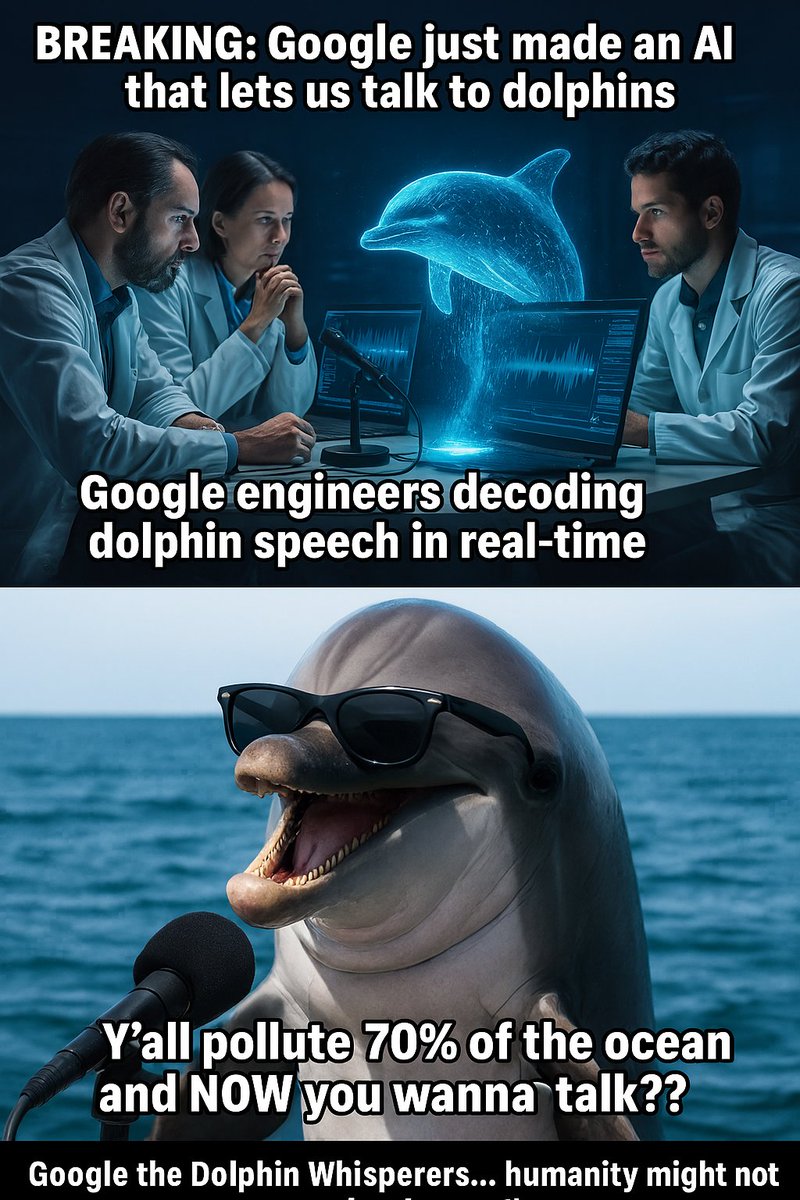
10/32
@minchoi
I don't think it's 70%
11/32
@eddie365_
That’s crazy!
Just a matter of time until we are talking to our dogs! Lol
12/32
@minchoi
I'm surprised we haven't made progress like this with dogs yet!
13/32
@ankitamohnani28
Woah! Looks interesting
14/32
@minchoi
Could be the beginning of a really interesting research with AI
15/32
@Adintelnews
Atlantis, here I come!
16/32
@minchoi
Is it real?
17/32
@sozerberk
Google doesn’t take a break. Every day they release so much and showing that AI is much bigger than daily chatbots
18/32
@minchoi
Definitely awesome to see AI applications beyond chatbots
19/32
@vidxie
Talking to dolphins sounds incredible
20/32
@minchoi
This is just the beginning!
21/32
@jacobflowchat
imagine if we could actually chat with dolphins one day. the possibilities for understanding marine life are endless.
22/32
@minchoi
Any animals for that matter
23/32
@raw_works
you promised no more "wild". but i'll give you a break because dolphins are wild animals.
24/32
@minchoi
That was April Fools
25/32
@Calenyita
Conversations are better with octopodes
26/32
@minchoi
Oh?
27/32
@karlmehta
That's truly incredible
28/32
@karlmehta
What a time to be alive
29/32
@SUBBDofficial
wen Dolphin DAO
30/32
@VentureMindAI
This is insane
31/32
@ThisIsMeIn360VR
The dolphins just keep singing...
32/32
@vectro
@cognitivecompai
@minchoi
This is wild.
Google just built an AI model that might help us talk to dolphins.
It’s called DolphinGemma.
And they used a Google Pixel to listen and analyze.
https://video.twimg.com/amplify_video/1911767019344531456/vid/avc1/1080x1920/XMoZ_rgM3cVPK2Kz.mp4
2/32
@minchoi
Researchers used Pixel phones to listen, analyze, and talk back to dolphins in real time.
https://video.twimg.com/amplify_video/1911787266659287040/vid/avc1/1280x720/20s83WXZnFY8tI_N.mp4
3/32
@minchoi
Read the blog here:
DolphinGemma: How Google AI is helping decode dolphin communication
4/32
@minchoi
If you enjoyed this thread,
Follow me @minchoi and please Bookmark, Like, Comment & Repost the first Post below to share with your friends:
[Quoted tweet]
This is wild.
Google just built an AI model that might help us talk to dolphins.
It’s called DolphinGemma.
And they used a Google Pixel to listen and analyze.
[media=twitter]1911789107803480396[/media]
https://video.twimg.com/amplify_video/1911767019344531456/vid/avc1/1080x1920/XMoZ_rgM3cVPK2Kz.mp4
5/32
@shawnchauhan1
This is next-level!
6/32
@minchoi
Truly wild
7/32
@Native_M2
Awesome! They should do dogs next
8/32
@minchoi
Yea why haven't we?
9/32
@mememuncher420

10/32
@minchoi
I don't think it's 70%
11/32
@eddie365_
That’s crazy!
Just a matter of time until we are talking to our dogs! Lol
12/32
@minchoi
I'm surprised we haven't made progress like this with dogs yet!
13/32
@ankitamohnani28
Woah! Looks interesting
14/32
@minchoi
Could be the beginning of a really interesting research with AI
15/32
@Adintelnews
Atlantis, here I come!
16/32
@minchoi
Is it real?
17/32
@sozerberk
Google doesn’t take a break. Every day they release so much and showing that AI is much bigger than daily chatbots
18/32
@minchoi
Definitely awesome to see AI applications beyond chatbots
19/32
@vidxie
Talking to dolphins sounds incredible
20/32
@minchoi
This is just the beginning!
21/32
@jacobflowchat
imagine if we could actually chat with dolphins one day. the possibilities for understanding marine life are endless.
22/32
@minchoi
Any animals for that matter
23/32
@raw_works
you promised no more "wild". but i'll give you a break because dolphins are wild animals.
24/32
@minchoi
That was April Fools
25/32
@Calenyita
Conversations are better with octopodes
26/32
@minchoi
Oh?
27/32
@karlmehta
That's truly incredible
28/32
@karlmehta
What a time to be alive
29/32
@SUBBDofficial
wen Dolphin DAO
30/32
@VentureMindAI
This is insane
31/32
@ThisIsMeIn360VR
The dolphins just keep singing...
32/32
@vectro
@cognitivecompai
1/10
@productfella
For the first time in human history, we might talk to another species:
Google has built an AI that processes dolphin sounds as language.
40 years of underwater recordings revealed they use "names" to find each other.
This summer, we'll discover what else they've been saying all along:
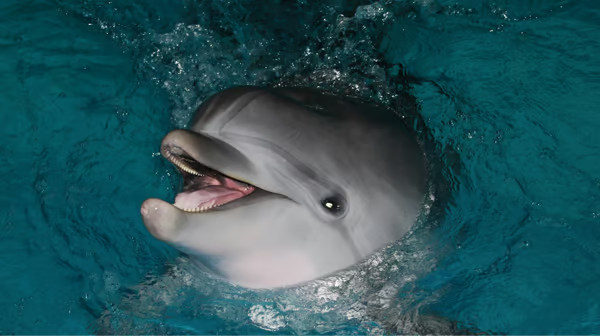

2/10
@productfella
Since 1985, researchers collected 40,000 hours of dolphin recordings.
The data sat impenetrable for decades.
Until Google created something extraordinary:
https://video.twimg.com/amplify_video/1913253714569334785/vid/avc1/1280x720/7bQ5iccyKXdukfkD.mp4
3/10
@productfella
Meet DolphinGemma - an AI with just 400M parameters.
That's 0.02% of GPT-4's size.
Yet it's cracking a code that stumped scientists for generations.
The secret? They found something fascinating:
https://video.twimg.com/amplify_video/1913253790805004288/vid/avc1/1280x720/UQXv-jbjVfOK1yYQ.mp4
4/10
@productfella
Every dolphin creates a unique whistle in its first year.
It's their name.
Mothers call calves with these whistles when separated.
But the vocalizations contain far more:
https://video.twimg.com/amplify_video/1913253847348523008/vid/avc1/1280x720/hopgMWjTADY5yMzs.mp4
5/10
@productfella
Researchers discovered distinct patterns:
• Signature whistles as IDs
• "Squawks" during conflicts
• "Buzzes" in courtship and hunting
Then came the breakthrough:
https://video.twimg.com/amplify_video/1913253887269888002/vid/avc1/1280x720/IbgvfHsht7RogPVp.mp4
6/10
@productfella
DolphinGemma processes sound like human language.
It runs entirely on a smartphone.
Catches patterns humans missed for decades.
The results stunned marine biologists:
https://video.twimg.com/amplify_video/1913253944094347264/vid/avc1/1280x720/1QDbwkSD0x6etHn9.mp4
7/10
@productfella
The system achieves 87% accuracy across 32 vocalization types.
Nearly matches human experts.
Reveals patterns invisible to traditional analysis.
This changes everything for conservation:
https://video.twimg.com/amplify_video/1913253989266927616/vid/avc1/1280x720/1sI9ts2JrY7p0Pjw.mp4
8/10
@productfella
Three critical impacts:
• Tracks population through voices
• Detects environmental threats
• Protects critical habitats
But there's a bigger story here:
https://video.twimg.com/amplify_video/1913254029293146113/vid/avc1/1280x720/c1poqHVhgt22SgE8.mp4
9/10
@productfella
The future isn't bigger AI—it's smarter, focused models.
Just as we're decoding dolphin language, imagine what other secrets we could unlock in specialized data.
We might be on the verge of understanding nature in ways never before possible.
10/10
@productfella
Video credits:
- Could we speak the language of dolphins? | Denise Herzing | TED
- Google's AI Can Now Help Talk to Dolphins — Here’s How! | Front Page | AIM TV
- ‘Speaking Dolphin’ to AI Data Dominance, 4.1 + Kling 2.0: 7 Updates Critically Analysed
@productfella
For the first time in human history, we might talk to another species:
Google has built an AI that processes dolphin sounds as language.
40 years of underwater recordings revealed they use "names" to find each other.
This summer, we'll discover what else they've been saying all along:


2/10
@productfella
Since 1985, researchers collected 40,000 hours of dolphin recordings.
The data sat impenetrable for decades.
Until Google created something extraordinary:
https://video.twimg.com/amplify_video/1913253714569334785/vid/avc1/1280x720/7bQ5iccyKXdukfkD.mp4
3/10
@productfella
Meet DolphinGemma - an AI with just 400M parameters.
That's 0.02% of GPT-4's size.
Yet it's cracking a code that stumped scientists for generations.
The secret? They found something fascinating:
https://video.twimg.com/amplify_video/1913253790805004288/vid/avc1/1280x720/UQXv-jbjVfOK1yYQ.mp4
4/10
@productfella
Every dolphin creates a unique whistle in its first year.
It's their name.
Mothers call calves with these whistles when separated.
But the vocalizations contain far more:
https://video.twimg.com/amplify_video/1913253847348523008/vid/avc1/1280x720/hopgMWjTADY5yMzs.mp4
5/10
@productfella
Researchers discovered distinct patterns:
• Signature whistles as IDs
• "Squawks" during conflicts
• "Buzzes" in courtship and hunting
Then came the breakthrough:
https://video.twimg.com/amplify_video/1913253887269888002/vid/avc1/1280x720/IbgvfHsht7RogPVp.mp4
6/10
@productfella
DolphinGemma processes sound like human language.
It runs entirely on a smartphone.
Catches patterns humans missed for decades.
The results stunned marine biologists:
https://video.twimg.com/amplify_video/1913253944094347264/vid/avc1/1280x720/1QDbwkSD0x6etHn9.mp4
7/10
@productfella
The system achieves 87% accuracy across 32 vocalization types.
Nearly matches human experts.
Reveals patterns invisible to traditional analysis.
This changes everything for conservation:
https://video.twimg.com/amplify_video/1913253989266927616/vid/avc1/1280x720/1sI9ts2JrY7p0Pjw.mp4
8/10
@productfella
Three critical impacts:
• Tracks population through voices
• Detects environmental threats
• Protects critical habitats
But there's a bigger story here:
https://video.twimg.com/amplify_video/1913254029293146113/vid/avc1/1280x720/c1poqHVhgt22SgE8.mp4
9/10
@productfella
The future isn't bigger AI—it's smarter, focused models.
Just as we're decoding dolphin language, imagine what other secrets we could unlock in specialized data.
We might be on the verge of understanding nature in ways never before possible.
10/10
@productfella
Video credits:
- Could we speak the language of dolphins? | Denise Herzing | TED
- Google's AI Can Now Help Talk to Dolphins — Here’s How! | Front Page | AIM TV
- ‘Speaking Dolphin’ to AI Data Dominance, 4.1 + Kling 2.0: 7 Updates Critically Analysed







